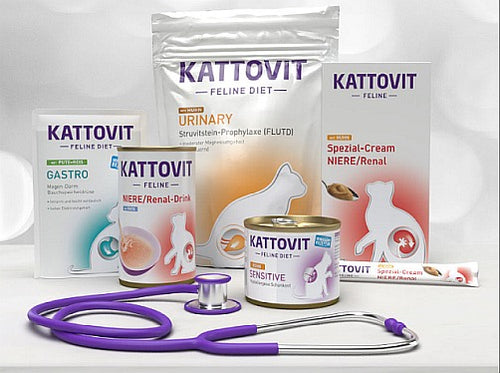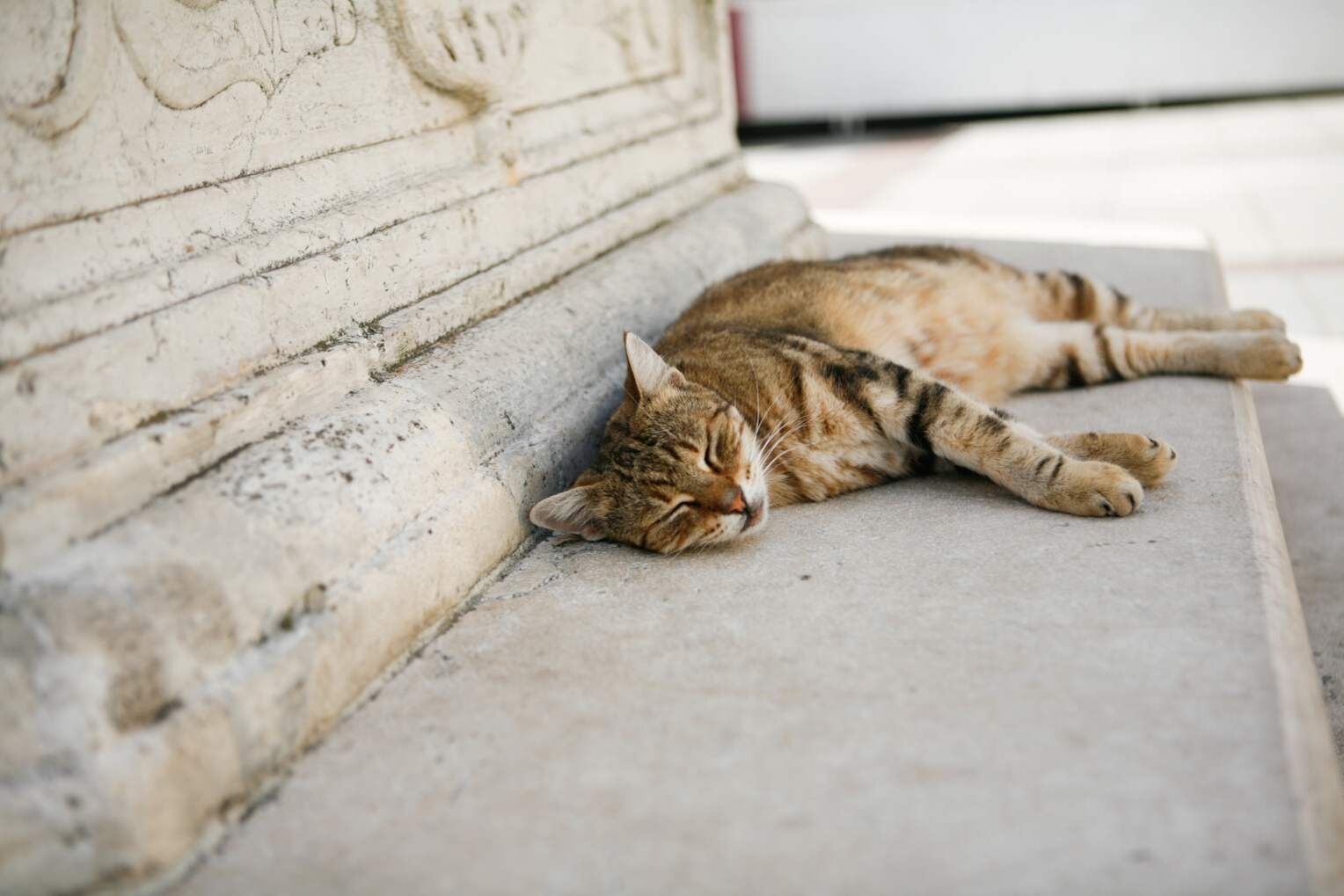Cats and heat - they actually go well together. It's not uncommon to see these furry friends lounging in the sun or lying on the heater. However, cats don't tolerate extreme heat in summer very well either. In the worst case, they can suffer from dangerous heat stroke. Find out here why extreme heat is hard on cats, what you need to pay particular attention to on hot days and how you can keep your house cat cool.
How do cats deal with heat?
As descendants of desert dwellers , cats are used to warm temperatures and enjoy having the sun shine on their fur. However, if temperatures rise above 30 degrees Celsius in spring or summer, this is also uncomfortable for the four-legged friends. This is mainly because cats only sweat to a limited extent and can only influence their body temperature to a limited extent.
Cats only have a few sweat glands on their paws. They rarely use these to sweat, but mostly to mark their territory using scent signals. For this reason, cats find it difficult to cope with the heat and cool their bodies on hot days. Overall, the animals behave very tired and sluggish in hot temperatures. A lot of activity is more strenuous in the heat, which is why they limit their movement.
Cats use evaporative cooling to cool their bodies. This is achieved by panting: the moisture on the tongue creates evaporative cooling in the throat when they pant. The animals also cool their bodies by more intensive grooming: by regularly licking their fur, it becomes moist due to the release of saliva and evaporative cooling also develops. It is therefore not necessarily unusual to see your furry friend panting and grooming itself more frequently in the summer.
[Drinks]
Is heat dangerous for cats?
Heat can be very dangerous for cats: If temperatures rise above 30 degrees Celsius and your cat cannot find a cool place to retreat to, panting and grooming will no longer help. In the worst case, heat stroke can occur, which can be life-threatening for the animals. You can recognize acute heat stroke in a cat by the following symptoms:
- Restless behavior
- Very heavy panting
- Dark red gums
- body temperature above 39 degrees Celsius
- apathy
- Rapid heartbeat
- tremors and cramps
- prone position
If your cat is panting more than usual , seems very restless or apathetic, trembles or cramps and lies on its stomach, these are clear warning signs and you should see a vet immediately. A rapid heartbeat, dark red gums and a high body temperature are other signs of heat stroke. However, remember that animals are generally very sluggish and lazy in high temperatures and their body temperature is normally higher than that of a human. If several unusual symptoms occur, you should always consult a vet to be on the safe side.
Another danger that cats face when it is too hot is dehydration . The animals lose a lot of fluid through panting and the increased release of saliva when grooming. As they hardly move due to the heat and burn fewer calories, they also eat less in hot weather. However, the animals usually meet a large part of their fluid requirements through food, especially wet food. In addition, they are lazy when it comes to drinking and quickly run the risk of not drinking enough.
If you suspect advanced dehydration , you should also go to the vet. A good way to check your cat's fluid balance is the skin fold test : To do this, use your fingers to press a fold of skin on the neck or back of your cat for a few seconds. If this fold remains for a longer period of time and does not smooth out immediately, there is a lack of fluid.
How to make the heat more bearable for cats
To ensure that your cat survives the heatwave well and does not suffer from heat stroke or dehydration, you can take a few precautions.
living situation
On hot days, it is important that your cat has a cool place to retreat to . This is especially true for indoor cats, as they have little choice within four walls. Outdoor cats, on the other hand, can look for a shady spot outside under plants or near a cooling body of water to avoid overheating.
If you have a garden or balcony at home, you should allow your house cat to spend time in the shade . Plants such as cat grass provide a cooler climate - but make sure that there are no poisonous plants within reach. To ensure that your cat is safe on the balcony or roof terrace, you should put up protective nets . The mesh should not be larger than three centimeters, however, so that the animal does not get tangled up in them and get stuck.
You should keep the air inside your home as cool as possible. As long as the temperature outside is still low, you should ventilate the room briefly - ideally early in the morning and in the evening. However, the windows should never be left open for long periods of time, as your cat could get stuck in the gap. During the day, it is advisable to keep the blinds and curtains closed to keep out the sun. This will keep the temperature inside the house comfortable for both humans and animals.
Many cats like to lie on a cold surface such as tiles, shower trays or sinks when it is hot. Therefore, give your house cat access to the bathroom or other cool rooms, such as the basement, at all times. Alternatively, you can create cold places to lie down yourself by laying out damp towels.
Many people turn to fans when the temperature in the house is uncomfortably high. As a cat owner, you need to be careful: fans pose a high risk of injury for curious and playful cats. If the fan is permanently near your cat, it could catch a cold or develop conjunctivitis due to the cold draft.
Cooling your cat in hot weather
To help your cat cool down, rub her down with a damp cloth or apply cold compresses . If your cat likes this, you can also spray her fur with water to provide additional evaporative cooling.
On hot days, four-legged friends also suffer from their fur, which quickly causes them to overheat. For this reason, long-haired cats shed more fur in the summer to relieve themselves of the strenuous burden. You can help your furry friend to remove excess hair by brushing them regularly .
Cat food and drink in hot weather
To ensure that your furry friend does not overheat and become dehydrated on hot days, it is very important that he eats and drinks enough. You should give him wet food preference over dry food because the liquid contained in wet food contributes greatly to meeting the animals' fluid requirements.
Since cats have a harder time digesting food in hot weather, distribute the food in smaller portions throughout the day and do not leave it standing for too long. In very hot weather there is a risk that the food will quickly become unappetizing or that flies will lay their eggs in it.
If you store your pet's cat food in the refrigerator in summer, it is not advisable to serve it straight away. Food that is too cold will irritate your cat's stomach. Instead, the food should be kept at room temperature be served.
In addition to sufficient food, you should provide your furry friend with various places in the apartment drinking options and ensure that fresh water is always available. With a drinking fountain or water feature, you can increase the attractiveness of the water even more. An ice cube in the water bowl or a varied drink such as unsalted broth, tuna water or cat drinks make liquid intake even more palatable for your pet. You can find more tips on how to encourage your cat to drink in this guide.
What else you should consider in hot weather
What may seem surprising to many is the fact that cats can also get sunburned. Light-colored and short-haired cats are particularly at increased risk of sunburn. To prevent this from happening, you can rub sunscreen on your furry friend's nose and ears. Unscented sunscreen for babies with a sun protection factor of at least 30 is best for preventing sunburn in cats.
You should also make sure that you do not leave your house cat alone for too long in hot weather. Even if you are only away for one or two nights, you should organize vacation care and have a trustworthy person check on your cat regularly and ensure that it has enough food and drink. The same applies to transport in vehicles: If you take your animal with you in the car when you travel or on the way to or from the vet, you should never leave it alone in the vehicle for long periods of time. In strong sunlight and high outside temperatures, cars heat up to high temperatures in a very short time and become dangerous traps.
Another danger in the summer months comes from insects : ticks and fleas are particularly active at this time. Therefore, check your cat regularly for unwanted visitors and remove them immediately.









